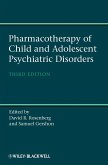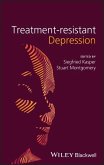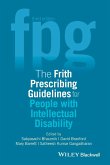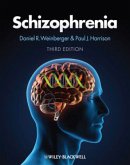Bipolar Psychopharmacotherapy
Caring for the Patient
Ed. by Akiskal, Hagop S.; Tohen, Mauricio
Bipolar Psychopharmacotherapy
Caring for the Patient
Ed. by Akiskal, Hagop S.; Tohen, Mauricio
- Gebundenes Buch
- Merkliste
- Auf die Merkliste
- Bewerten Bewerten
- Teilen
- Produkt teilen
- Produkterinnerung
- Produkterinnerung
"If a colleague were to ask me, "What would you recommend I read if I want to become a real expert on bipolarity?" I would respond Bipolar Psychopharmacotherapy: Caring for the Patient." Journal of Bipolar Disorders
And the second edition is even better! Bipolar Psychopharmacotherapy covers both pharmacotherapy and the supportive role of psychotherapy, psychoeducation and social approaches to provide a broad integrative philosophy of care for bipolar patients. Extensive coverage is given to special management issues such as the pharmacological care of women with bipolar disorder, children…mehr
Andere Kunden interessierten sich auch für
![Pharmacotherapy of Child and Adolescent Psychiatric Disorders Pharmacotherapy of Child and Adolescent Psychiatric Disorders]() Pharmacotherapy of Child and Adolescent Psychiatric Disorders132,99 €
Pharmacotherapy of Child and Adolescent Psychiatric Disorders132,99 €![Treatment-Resistant Depression Treatment-Resistant Depression]() Treatment-Resistant Depression53,99 €
Treatment-Resistant Depression53,99 €![The Frith Prescribing Guidelines for People with Intellectual Disability The Frith Prescribing Guidelines for People with Intellectual Disability]() Sabyasachi BhaumikThe Frith Prescribing Guidelines for People with Intellectual Disability81,99 €
Sabyasachi BhaumikThe Frith Prescribing Guidelines for People with Intellectual Disability81,99 €![Lishman's Organic Psychiatry Lishman's Organic Psychiatry]() Antony DavidLishman's Organic Psychiatry105,99 €
Antony DavidLishman's Organic Psychiatry105,99 €![Leadership in Psychiatry Leadership in Psychiatry]() Leadership in Psychiatry119,99 €
Leadership in Psychiatry119,99 €![Post-Traumatic Stress Disorders Post-Traumatic Stress Disorders]() William Yule (Hrsg.)Post-Traumatic Stress Disorders97,99 €
William Yule (Hrsg.)Post-Traumatic Stress Disorders97,99 €![Schizophrenia Schizophrenia]() Schizophrenia221,99 €
Schizophrenia221,99 €-
-
-
"If a colleague were to ask me, "What would you recommend I read if I want to become a real expert on bipolarity?" I would respond Bipolar Psychopharmacotherapy: Caring for the Patient."
Journal of Bipolar Disorders
And the second edition is even better! Bipolar Psychopharmacotherapy covers both pharmacotherapy and the supportive role of psychotherapy, psychoeducation and social approaches to provide a broad integrative philosophy of care for bipolar patients. Extensive coverage is given to special management issues such as the pharmacological care of women with bipolar disorder, children and the elderly, as well as bipolar depression and suicide prevention.
The mood swings that characterize bipolar disorder can now be better stabilized in most patients than in the past, but the illness must be carefully managed throughout a person's life. Pharmacotherapy is central to the acute treatment and long-term management and as there are several classes of drugs which are often prescribed concurrently, treatment issues are complex. This essential reference work features critical reviews of the existing literature, plus information on new treatments that have been reported at peer reviewed scientific meetings, often written by the pioneering experts on a particular treatment. The second-generation antipsychotics are now covered in separate chapters to provide in-depth coverage of these agents. There are also new chapters on the pharmacological treatments of mixed states and rapid cycling and novel therapeutic vistas.
Hinweis: Dieser Artikel kann nur an eine deutsche Lieferadresse ausgeliefert werden.
Journal of Bipolar Disorders
And the second edition is even better! Bipolar Psychopharmacotherapy covers both pharmacotherapy and the supportive role of psychotherapy, psychoeducation and social approaches to provide a broad integrative philosophy of care for bipolar patients. Extensive coverage is given to special management issues such as the pharmacological care of women with bipolar disorder, children and the elderly, as well as bipolar depression and suicide prevention.
The mood swings that characterize bipolar disorder can now be better stabilized in most patients than in the past, but the illness must be carefully managed throughout a person's life. Pharmacotherapy is central to the acute treatment and long-term management and as there are several classes of drugs which are often prescribed concurrently, treatment issues are complex. This essential reference work features critical reviews of the existing literature, plus information on new treatments that have been reported at peer reviewed scientific meetings, often written by the pioneering experts on a particular treatment. The second-generation antipsychotics are now covered in separate chapters to provide in-depth coverage of these agents. There are also new chapters on the pharmacological treatments of mixed states and rapid cycling and novel therapeutic vistas.
Hinweis: Dieser Artikel kann nur an eine deutsche Lieferadresse ausgeliefert werden.
Produktdetails
- Produktdetails
- Verlag: Wiley & Sons
- 2. Aufl.
- Seitenzahl: 544
- Erscheinungstermin: 25. April 2011
- Englisch
- Abmessung: 249mm x 175mm x 33mm
- Gewicht: 1080g
- ISBN-13: 9780470747216
- ISBN-10: 0470747218
- Artikelnr.: 33239098
- Herstellerkennzeichnung
- Libri GmbH
- Europaallee 1
- 36244 Bad Hersfeld
- gpsr@libri.de
- Verlag: Wiley & Sons
- 2. Aufl.
- Seitenzahl: 544
- Erscheinungstermin: 25. April 2011
- Englisch
- Abmessung: 249mm x 175mm x 33mm
- Gewicht: 1080g
- ISBN-13: 9780470747216
- ISBN-10: 0470747218
- Artikelnr.: 33239098
- Herstellerkennzeichnung
- Libri GmbH
- Europaallee 1
- 36244 Bad Hersfeld
- gpsr@libri.de
Hagop Akiskal is Distinguished Professor of Psychiatry and Director of the International Mood Center, San Diego Veterans Administration Medical Center, San Diego, California, USA. He was awarded the Jean Delay prize by the World Psychiatric Association in 2002 for research work that better bridges the gap between biological, psychological and social aspects of psychiatry and mental health. He has received the Gold Medal for Pioneer Research (Society of Biological Psychiatry), the German Anna Monika Prize for Depression, the NARSAD Prize for Affective Disorders, the French Jules Baillarger and the Italian Aretaeus Prizes for his research on the bipolar spectrum. He is Editor-in-Chief of the Journal of Affective Disorders. Mauricio Tohen was appointed to the Krus endowed chair in Psychiatry at the University of Texas Health Science Centre at San Antonio in 2009. He is Chief of the Division of Mood and Anxiety Disorders, Department of Psychiatry, University of Texas Health Science Centre, San Antonio, Texas, USA. He is President of the International Society for Bipolar Disorders (2010 - 2012). His research has focused on the clinical epidemiology and psychopharmacological treatments of bipolar disorder. Professor Tohen has over 200 original publications and over 500 book chapters and scientific abstracts. He has co-edited Mood Disorders Across the Lifespan and Textbook of Psychiatric Epidemiology, and has also edited Comorbidity in Affective Disorders.
List of Contributors.
Preface to the Second Edition.
Chapter 1 The scope of bipolar disorders (Hagop S. Akiskal).
1.1 Diagnostic and public health aspects.
1.2 Psychological and social aspects.
Chapter 2 Lithium treatment: Focus on long-term prophylaxis (Paul Grof and
Mogens Schou).
2.1 Introduction.
2.2 Cade's pioneering study.
2.3 Discovery of the prophylactic action of lithium.
2.4 Practical issues.
2.5 Are new and better prophylactic agents about to oust lithium?
2.6 Combination treatment.
2.7 Prophylaxis in recurrent depressive disorder.
2.8 The effect of lithium on the patients' suicidal behavior.
2.9 Benefits of prophylactic lithium treatment.
2.10 Conclusion.
Chapter 3 Valproate: Clinical pharmacological profile (Charles L. Bowden
and Vivek Singh).
3.1 Historical background.
3.2 Structure-activity relationships.
3.3 Pharmacodynamic properties.
3.4 Pharmacokinetics and metabolic clearance.
3.5 Serum concentration and efficacy.
3.6 Efficacy and indications.
3.7 Efficacy in bipolar disorder.
3.8 Combination strategy in acute mania.
3.9 Prophylaxis in bipolar disorder.
3.10 Treatment of bipolar depression.
3.11 Valproate in treatment of bipolar disorder in children and
adolescents.
3.12 Use in bipolar illness comorbid with alcoholism.
3.13 Bipolar disorder comorbid with ADHD.
3.14 Bipolar disorder comorbid with borderline personality disorder.
3.15 Adverse effects.
3.16 Comparative adverse effects.
3.17 Adverse effects in combination therapy, compared with monotherapy.
3.18 Adverse effects by bodily system.
3.19 Summary.
Chapter 4 Pharmacological profile and clinical utility of lamotrigine in
mood disorders (Marc L.M. van der Loos, Joseph R. Calabrese, Willem A.
Nolen and David J. Muzina).
4.1 Introduction.
4.2 Clinical pharmacology of lamotrigine.
4.3 Lamotrigine and mood disorders.
4.4 Safety.
4.5 Clinical applications for lamotrigine in mood disorders.
4.6 Summary.
Chapter 5 Carbamazepine and other anticonvulsants (Heinz Grunze).
5.1 Introduction.
5.2 Conclusions.
Chapter 6 Olanzapine in treatment for bipolar disorder (Mauricio Tohen,
Giedra Campbell and Juan-Carlos Gomez).
6.1 Introduction.
6.2 Rationale in the clinical trial development of olanzapine.
6.3 Efficacy in the treatment of acute mania.
6.4 Efficacy in the treatment of bipolar depression.
6.5 Efficacy in bipolar maintenance/relapse prevention.
6.6 Safety and tolerability.
6.7 Summary.
Chapter 7 Haloperidol and other first generation antipsychotics in mania (
John Cookson).
7.1 Introduction.
7.2 Acute tranquillization in mania.
7.3 Sedation is not required for antipsychotics to improve mania.
7.4 Chlorpromazine in mania.
7.5 Haloperidol in mania.
7.6 Hormone changes and mechanisms of antimanic effects of antipsychotics.
7.7 Antipsychotics as mood stabilizers.
7.8 Placebo-controlled studies in mania.
7.9 Recent comparative trials without placebo.
7.10 Pharmacoeconomics.
7.11 Conclusions.
Chapter 8 Clinical utility of clozapine in bipolar disorder (V.E. Cosgrove,
J.S. Seo, H. Yang and Trisha Suppes).
8.1 Introduction.
8.2 History.
8.3 Clinical pharmacology of clozapine.
8.4 Clozapine in bipolar disorders.
8.5 Effective pharmacotherapy for bipolar disorder?
8.6 Case studies.
Chapter 9 Risperidone and paliperidone in the treatment of bipolar disorder
(L. Ivo Caers and Joris Berwaerts).
9.1 Introduction.
9.2 Oral risperidone in bipolar mania.
9.3 Paliperidone extended release (ER) in bipolar mania.
9.4 Risperidone long-acting injectable (LAI) in the maintenance treatment
of bipolar disorder.
9.5 Elements of special interest.
9.6 Summary and conclusions.
Chapter 10 Quetiapine in bipolar disorder (Mauricio Kunz, Svante Nyberg and
Lakshmi N. Yatham).
10.1 Introduction.
10.2 Pharmacology.
10.3 Quetiapine in the treatment of acute mania.
10.4 Quetiapine in the treatment of acute bipolar depression.
10.5 Quetiapine in the maintenance treatment of bipolar disorder.
10.6 Safety and tolerability of quetiapine.
10.7 Summary.
Chapter 11 Ziprasidone in the treatment of bipolar disorder (Thomas L.
Schwartz, Stephen M. Stahl, Elizabeth Pappadopulos and Onur N. Karayal).
11.1 Introduction.
11.2 Ziprasidone and its proposed mechanism of action.
11.3 Ziprasidone in treatment guidelines.
11.4 Overview of ziprasidone efficacy from clinical trial data.
11.5 Acute manic/mixed episodes.
11.6 Acute depressive episodes.
11.7 Long term maintenance treatment of bipolar disorder.
11.8 Practical guidance on the use of ziprasidone in bipolar disorder.
11.9 Safety and tolerability.
11.10 Treatment of special populations.
11.11 Summary and conclusions.
Chapter 12 Aripiprazole in bipolar disorder (Alessandra Nivoli and Eduard
Vieta).
12.1 Aripiprazole and its mode of action.
12.2 Aripiprazole in treatment guidelines.
12.3 Aripiprazole efficacy from clinical trial data.
12.4 Aripiprazole safety and tolerability.
12.5 Treatment of special populations.
12.6 Pharmacogenetics of aripiprazole.
Chapter 13 Asenapine in bipolar disorder (Roger S. McIntyre).
13.1 Introduction.
13.2 Pharmacology.
13.3 Human pharmacokinetics.
13.4 Asenapine: Efficacy in bipolar mania and mixed states.
13.5 Asenapine: Efficacy and tolerability during extension treatment.
13.6 Summary and conclusion.
Chapter 14 Complex combination therapy for long-term stability in bipolar
disorder (Robert M. Post).
14.1 Introduction.
14.2 Rationale for complex combination therapy in bipolar illness.
14.3 Principles of building an effective therapeutic regimen.
14.4 Conclusions.
Chapter 15 The role of antidepressants in bipolar disorder (Boghos I.
Yerevanian).
15.1 Introduction.
15.2 Tricyclic antidepressants.
15.3 MAO inhibitors.
15.4 SSRIs.
15.5 SNRIs: Venlafaxine, mirtazapine, duloxetine.
15.6 Bupropion.
15.7 Clinical and research implications.
Chapter 16 Bipolarity in women: Therapeutic issues (Susan L. McElroy,
Lesley M. Arnold and Lori L. Altshuler).
16.1 Introduction.
16.2 Epidemiology and gender distribution of the bipolar spectrum.
16.3 Gender differences in phenomenology.
16.4 Gender differences in course and outcome.
16.5 Gender differences in comorbidity.
16.6 Bipolar disorder and the reproductive cycle.
16.7 Treatment of bipolar disorder in females.
16.8 Summary.
Chapter 17 Pediatric bipolar disorder: The promise of psychopharmacotherapy
(Tiffany Thomas and Robert L. Findling).
17.1 Introduction.
17.2 Lithium.
17.3 Anticonvulsants.
17.4 Antipsychotics.
17.5 Conclusion.
Chapter 18 Treatment of bipolar disorder in old age (Kenneth I. Shulman,
Nathan Herrmann and Martha Sajatovic).
18.1 Treatment of bipolar disorder in old age.
18.2 Management of bipolar disorder in the elderly.
18.3 Treatment of bipolar depression in older adults.
18.4 The future.
Chapter 19 Diagnosis and treatment of mixed states (Alan C. Swann).
19.1 What is a mixed state?
19.2 General considerations for treatment strategies in mixed states.
19.3 Treating mania in mixed states.
19.4 Treating depression in mixed states.
19.5 Nonpharmacological treatments.
19.6 An Integrated model for treating mixed states.
19.7 Conclusions.
Chapter 20 Rapid cycling of bipolar patients (Athanasios Koukopoulos, G.
Serra, F. Zazzara, A. E. Koukopoulos and G. Sani).
20.1 Introduction.
20.2 Epidemiological data.
20.3 Spontaneous and induced rapid cycling.
20.4 Temperament and rapid cycling.
20.5 Course.
20.6 Clinical picture of rapid cycling.
20.7 Neurobiology of rapid cycling bipolar disorder: The role of dopamine
D2 receptors, sensitization.
20.8 Treatment.
20.9 Discussion.
Chapter 21 Novel therapeutic approaches for treating bipolar disorder (
Rodrigo Machado-Vieira, Ioline Henter, Jacqueline Baumann, David Latov,
Cristina Wheeler-Castillo and Carlos A. Zarate).
21.1 Introduction.
21.2 The dynorphin opioid neuropeptide system.
21.3 The purinergic system.
21.4 The melatonergic system.
21.5 The glutamatergic system.
21.6 The tachykinin neuropeptides system.
21.7 The glucocorticoid system.
21.8 The arachidonic acid (AA) cascade.
21.9 The endocannabinoid system.
21.10 Oxidative stress and bioenergetics.
21.11 The intracellular signaling pathways.
21.12 Final remarks.
Chapter 22 The pivotal role of psycho-education in the long-term treatment
of bipolar disorder (Francesc Colom and Andrea Murru).
22.1 Introduction.
22.2 On the need for psycho-education.
22.3 The five ingredients of psycho-education.
22.4 Substance misuse avoidance.
22.5 Early warning signs - detection.
22.6 Lifestyle regularity (and miscellanea).
22.7 Psycho-education with the family.
22.8 Long-term follow-up.
22.9 The future.
22.10 Funding sources and acknowledgments.
Chapter 23 The role of treatment setting in the pharmacotherapy of bipolar
disorder (Jean-Michel Azorin).
23.1 Implementation of drug treatment according to phase and severity of
illness.
23.2 Pretreatment evaluation and monitoring of pharmacotherapy.
23.3 Drug response and treatment setting.
23.4 From efficacy to efficiency of pharmacotherapy in bipolar illness.
Chapter 24 Pharmacological prevention of suicide in bipolar patients (
Zoltan Rihmer).
24.1 Introduction.
24.2 Mood disorders and suicidal behavior.
24.3 Risk of suicidal behavior in bipolar disorders.
24.4 Suicide prevention in bipolar disorders.
Chapter 25 Overview of principles of caring for bipolar patients (Hagop S.
Akiskal and Kareen K. Akiskal).
25.1 Introduction.
25.2 The major players in bipolar disorder.
25.3 Principles of caring.
25.4 Special considerations for hypomanic and cyclothymic patients.
25.5 Conclusion.
References.
Index.
Preface to the Second Edition.
Chapter 1 The scope of bipolar disorders (Hagop S. Akiskal).
1.1 Diagnostic and public health aspects.
1.2 Psychological and social aspects.
Chapter 2 Lithium treatment: Focus on long-term prophylaxis (Paul Grof and
Mogens Schou).
2.1 Introduction.
2.2 Cade's pioneering study.
2.3 Discovery of the prophylactic action of lithium.
2.4 Practical issues.
2.5 Are new and better prophylactic agents about to oust lithium?
2.6 Combination treatment.
2.7 Prophylaxis in recurrent depressive disorder.
2.8 The effect of lithium on the patients' suicidal behavior.
2.9 Benefits of prophylactic lithium treatment.
2.10 Conclusion.
Chapter 3 Valproate: Clinical pharmacological profile (Charles L. Bowden
and Vivek Singh).
3.1 Historical background.
3.2 Structure-activity relationships.
3.3 Pharmacodynamic properties.
3.4 Pharmacokinetics and metabolic clearance.
3.5 Serum concentration and efficacy.
3.6 Efficacy and indications.
3.7 Efficacy in bipolar disorder.
3.8 Combination strategy in acute mania.
3.9 Prophylaxis in bipolar disorder.
3.10 Treatment of bipolar depression.
3.11 Valproate in treatment of bipolar disorder in children and
adolescents.
3.12 Use in bipolar illness comorbid with alcoholism.
3.13 Bipolar disorder comorbid with ADHD.
3.14 Bipolar disorder comorbid with borderline personality disorder.
3.15 Adverse effects.
3.16 Comparative adverse effects.
3.17 Adverse effects in combination therapy, compared with monotherapy.
3.18 Adverse effects by bodily system.
3.19 Summary.
Chapter 4 Pharmacological profile and clinical utility of lamotrigine in
mood disorders (Marc L.M. van der Loos, Joseph R. Calabrese, Willem A.
Nolen and David J. Muzina).
4.1 Introduction.
4.2 Clinical pharmacology of lamotrigine.
4.3 Lamotrigine and mood disorders.
4.4 Safety.
4.5 Clinical applications for lamotrigine in mood disorders.
4.6 Summary.
Chapter 5 Carbamazepine and other anticonvulsants (Heinz Grunze).
5.1 Introduction.
5.2 Conclusions.
Chapter 6 Olanzapine in treatment for bipolar disorder (Mauricio Tohen,
Giedra Campbell and Juan-Carlos Gomez).
6.1 Introduction.
6.2 Rationale in the clinical trial development of olanzapine.
6.3 Efficacy in the treatment of acute mania.
6.4 Efficacy in the treatment of bipolar depression.
6.5 Efficacy in bipolar maintenance/relapse prevention.
6.6 Safety and tolerability.
6.7 Summary.
Chapter 7 Haloperidol and other first generation antipsychotics in mania (
John Cookson).
7.1 Introduction.
7.2 Acute tranquillization in mania.
7.3 Sedation is not required for antipsychotics to improve mania.
7.4 Chlorpromazine in mania.
7.5 Haloperidol in mania.
7.6 Hormone changes and mechanisms of antimanic effects of antipsychotics.
7.7 Antipsychotics as mood stabilizers.
7.8 Placebo-controlled studies in mania.
7.9 Recent comparative trials without placebo.
7.10 Pharmacoeconomics.
7.11 Conclusions.
Chapter 8 Clinical utility of clozapine in bipolar disorder (V.E. Cosgrove,
J.S. Seo, H. Yang and Trisha Suppes).
8.1 Introduction.
8.2 History.
8.3 Clinical pharmacology of clozapine.
8.4 Clozapine in bipolar disorders.
8.5 Effective pharmacotherapy for bipolar disorder?
8.6 Case studies.
Chapter 9 Risperidone and paliperidone in the treatment of bipolar disorder
(L. Ivo Caers and Joris Berwaerts).
9.1 Introduction.
9.2 Oral risperidone in bipolar mania.
9.3 Paliperidone extended release (ER) in bipolar mania.
9.4 Risperidone long-acting injectable (LAI) in the maintenance treatment
of bipolar disorder.
9.5 Elements of special interest.
9.6 Summary and conclusions.
Chapter 10 Quetiapine in bipolar disorder (Mauricio Kunz, Svante Nyberg and
Lakshmi N. Yatham).
10.1 Introduction.
10.2 Pharmacology.
10.3 Quetiapine in the treatment of acute mania.
10.4 Quetiapine in the treatment of acute bipolar depression.
10.5 Quetiapine in the maintenance treatment of bipolar disorder.
10.6 Safety and tolerability of quetiapine.
10.7 Summary.
Chapter 11 Ziprasidone in the treatment of bipolar disorder (Thomas L.
Schwartz, Stephen M. Stahl, Elizabeth Pappadopulos and Onur N. Karayal).
11.1 Introduction.
11.2 Ziprasidone and its proposed mechanism of action.
11.3 Ziprasidone in treatment guidelines.
11.4 Overview of ziprasidone efficacy from clinical trial data.
11.5 Acute manic/mixed episodes.
11.6 Acute depressive episodes.
11.7 Long term maintenance treatment of bipolar disorder.
11.8 Practical guidance on the use of ziprasidone in bipolar disorder.
11.9 Safety and tolerability.
11.10 Treatment of special populations.
11.11 Summary and conclusions.
Chapter 12 Aripiprazole in bipolar disorder (Alessandra Nivoli and Eduard
Vieta).
12.1 Aripiprazole and its mode of action.
12.2 Aripiprazole in treatment guidelines.
12.3 Aripiprazole efficacy from clinical trial data.
12.4 Aripiprazole safety and tolerability.
12.5 Treatment of special populations.
12.6 Pharmacogenetics of aripiprazole.
Chapter 13 Asenapine in bipolar disorder (Roger S. McIntyre).
13.1 Introduction.
13.2 Pharmacology.
13.3 Human pharmacokinetics.
13.4 Asenapine: Efficacy in bipolar mania and mixed states.
13.5 Asenapine: Efficacy and tolerability during extension treatment.
13.6 Summary and conclusion.
Chapter 14 Complex combination therapy for long-term stability in bipolar
disorder (Robert M. Post).
14.1 Introduction.
14.2 Rationale for complex combination therapy in bipolar illness.
14.3 Principles of building an effective therapeutic regimen.
14.4 Conclusions.
Chapter 15 The role of antidepressants in bipolar disorder (Boghos I.
Yerevanian).
15.1 Introduction.
15.2 Tricyclic antidepressants.
15.3 MAO inhibitors.
15.4 SSRIs.
15.5 SNRIs: Venlafaxine, mirtazapine, duloxetine.
15.6 Bupropion.
15.7 Clinical and research implications.
Chapter 16 Bipolarity in women: Therapeutic issues (Susan L. McElroy,
Lesley M. Arnold and Lori L. Altshuler).
16.1 Introduction.
16.2 Epidemiology and gender distribution of the bipolar spectrum.
16.3 Gender differences in phenomenology.
16.4 Gender differences in course and outcome.
16.5 Gender differences in comorbidity.
16.6 Bipolar disorder and the reproductive cycle.
16.7 Treatment of bipolar disorder in females.
16.8 Summary.
Chapter 17 Pediatric bipolar disorder: The promise of psychopharmacotherapy
(Tiffany Thomas and Robert L. Findling).
17.1 Introduction.
17.2 Lithium.
17.3 Anticonvulsants.
17.4 Antipsychotics.
17.5 Conclusion.
Chapter 18 Treatment of bipolar disorder in old age (Kenneth I. Shulman,
Nathan Herrmann and Martha Sajatovic).
18.1 Treatment of bipolar disorder in old age.
18.2 Management of bipolar disorder in the elderly.
18.3 Treatment of bipolar depression in older adults.
18.4 The future.
Chapter 19 Diagnosis and treatment of mixed states (Alan C. Swann).
19.1 What is a mixed state?
19.2 General considerations for treatment strategies in mixed states.
19.3 Treating mania in mixed states.
19.4 Treating depression in mixed states.
19.5 Nonpharmacological treatments.
19.6 An Integrated model for treating mixed states.
19.7 Conclusions.
Chapter 20 Rapid cycling of bipolar patients (Athanasios Koukopoulos, G.
Serra, F. Zazzara, A. E. Koukopoulos and G. Sani).
20.1 Introduction.
20.2 Epidemiological data.
20.3 Spontaneous and induced rapid cycling.
20.4 Temperament and rapid cycling.
20.5 Course.
20.6 Clinical picture of rapid cycling.
20.7 Neurobiology of rapid cycling bipolar disorder: The role of dopamine
D2 receptors, sensitization.
20.8 Treatment.
20.9 Discussion.
Chapter 21 Novel therapeutic approaches for treating bipolar disorder (
Rodrigo Machado-Vieira, Ioline Henter, Jacqueline Baumann, David Latov,
Cristina Wheeler-Castillo and Carlos A. Zarate).
21.1 Introduction.
21.2 The dynorphin opioid neuropeptide system.
21.3 The purinergic system.
21.4 The melatonergic system.
21.5 The glutamatergic system.
21.6 The tachykinin neuropeptides system.
21.7 The glucocorticoid system.
21.8 The arachidonic acid (AA) cascade.
21.9 The endocannabinoid system.
21.10 Oxidative stress and bioenergetics.
21.11 The intracellular signaling pathways.
21.12 Final remarks.
Chapter 22 The pivotal role of psycho-education in the long-term treatment
of bipolar disorder (Francesc Colom and Andrea Murru).
22.1 Introduction.
22.2 On the need for psycho-education.
22.3 The five ingredients of psycho-education.
22.4 Substance misuse avoidance.
22.5 Early warning signs - detection.
22.6 Lifestyle regularity (and miscellanea).
22.7 Psycho-education with the family.
22.8 Long-term follow-up.
22.9 The future.
22.10 Funding sources and acknowledgments.
Chapter 23 The role of treatment setting in the pharmacotherapy of bipolar
disorder (Jean-Michel Azorin).
23.1 Implementation of drug treatment according to phase and severity of
illness.
23.2 Pretreatment evaluation and monitoring of pharmacotherapy.
23.3 Drug response and treatment setting.
23.4 From efficacy to efficiency of pharmacotherapy in bipolar illness.
Chapter 24 Pharmacological prevention of suicide in bipolar patients (
Zoltan Rihmer).
24.1 Introduction.
24.2 Mood disorders and suicidal behavior.
24.3 Risk of suicidal behavior in bipolar disorders.
24.4 Suicide prevention in bipolar disorders.
Chapter 25 Overview of principles of caring for bipolar patients (Hagop S.
Akiskal and Kareen K. Akiskal).
25.1 Introduction.
25.2 The major players in bipolar disorder.
25.3 Principles of caring.
25.4 Special considerations for hypomanic and cyclothymic patients.
25.5 Conclusion.
References.
Index.
List of Contributors.
Preface to the Second Edition.
Chapter 1 The scope of bipolar disorders (Hagop S. Akiskal).
1.1 Diagnostic and public health aspects.
1.2 Psychological and social aspects.
Chapter 2 Lithium treatment: Focus on long-term prophylaxis (Paul Grof and
Mogens Schou).
2.1 Introduction.
2.2 Cade's pioneering study.
2.3 Discovery of the prophylactic action of lithium.
2.4 Practical issues.
2.5 Are new and better prophylactic agents about to oust lithium?
2.6 Combination treatment.
2.7 Prophylaxis in recurrent depressive disorder.
2.8 The effect of lithium on the patients' suicidal behavior.
2.9 Benefits of prophylactic lithium treatment.
2.10 Conclusion.
Chapter 3 Valproate: Clinical pharmacological profile (Charles L. Bowden
and Vivek Singh).
3.1 Historical background.
3.2 Structure-activity relationships.
3.3 Pharmacodynamic properties.
3.4 Pharmacokinetics and metabolic clearance.
3.5 Serum concentration and efficacy.
3.6 Efficacy and indications.
3.7 Efficacy in bipolar disorder.
3.8 Combination strategy in acute mania.
3.9 Prophylaxis in bipolar disorder.
3.10 Treatment of bipolar depression.
3.11 Valproate in treatment of bipolar disorder in children and
adolescents.
3.12 Use in bipolar illness comorbid with alcoholism.
3.13 Bipolar disorder comorbid with ADHD.
3.14 Bipolar disorder comorbid with borderline personality disorder.
3.15 Adverse effects.
3.16 Comparative adverse effects.
3.17 Adverse effects in combination therapy, compared with monotherapy.
3.18 Adverse effects by bodily system.
3.19 Summary.
Chapter 4 Pharmacological profile and clinical utility of lamotrigine in
mood disorders (Marc L.M. van der Loos, Joseph R. Calabrese, Willem A.
Nolen and David J. Muzina).
4.1 Introduction.
4.2 Clinical pharmacology of lamotrigine.
4.3 Lamotrigine and mood disorders.
4.4 Safety.
4.5 Clinical applications for lamotrigine in mood disorders.
4.6 Summary.
Chapter 5 Carbamazepine and other anticonvulsants (Heinz Grunze).
5.1 Introduction.
5.2 Conclusions.
Chapter 6 Olanzapine in treatment for bipolar disorder (Mauricio Tohen,
Giedra Campbell and Juan-Carlos Gomez).
6.1 Introduction.
6.2 Rationale in the clinical trial development of olanzapine.
6.3 Efficacy in the treatment of acute mania.
6.4 Efficacy in the treatment of bipolar depression.
6.5 Efficacy in bipolar maintenance/relapse prevention.
6.6 Safety and tolerability.
6.7 Summary.
Chapter 7 Haloperidol and other first generation antipsychotics in mania (
John Cookson).
7.1 Introduction.
7.2 Acute tranquillization in mania.
7.3 Sedation is not required for antipsychotics to improve mania.
7.4 Chlorpromazine in mania.
7.5 Haloperidol in mania.
7.6 Hormone changes and mechanisms of antimanic effects of antipsychotics.
7.7 Antipsychotics as mood stabilizers.
7.8 Placebo-controlled studies in mania.
7.9 Recent comparative trials without placebo.
7.10 Pharmacoeconomics.
7.11 Conclusions.
Chapter 8 Clinical utility of clozapine in bipolar disorder (V.E. Cosgrove,
J.S. Seo, H. Yang and Trisha Suppes).
8.1 Introduction.
8.2 History.
8.3 Clinical pharmacology of clozapine.
8.4 Clozapine in bipolar disorders.
8.5 Effective pharmacotherapy for bipolar disorder?
8.6 Case studies.
Chapter 9 Risperidone and paliperidone in the treatment of bipolar disorder
(L. Ivo Caers and Joris Berwaerts).
9.1 Introduction.
9.2 Oral risperidone in bipolar mania.
9.3 Paliperidone extended release (ER) in bipolar mania.
9.4 Risperidone long-acting injectable (LAI) in the maintenance treatment
of bipolar disorder.
9.5 Elements of special interest.
9.6 Summary and conclusions.
Chapter 10 Quetiapine in bipolar disorder (Mauricio Kunz, Svante Nyberg and
Lakshmi N. Yatham).
10.1 Introduction.
10.2 Pharmacology.
10.3 Quetiapine in the treatment of acute mania.
10.4 Quetiapine in the treatment of acute bipolar depression.
10.5 Quetiapine in the maintenance treatment of bipolar disorder.
10.6 Safety and tolerability of quetiapine.
10.7 Summary.
Chapter 11 Ziprasidone in the treatment of bipolar disorder (Thomas L.
Schwartz, Stephen M. Stahl, Elizabeth Pappadopulos and Onur N. Karayal).
11.1 Introduction.
11.2 Ziprasidone and its proposed mechanism of action.
11.3 Ziprasidone in treatment guidelines.
11.4 Overview of ziprasidone efficacy from clinical trial data.
11.5 Acute manic/mixed episodes.
11.6 Acute depressive episodes.
11.7 Long term maintenance treatment of bipolar disorder.
11.8 Practical guidance on the use of ziprasidone in bipolar disorder.
11.9 Safety and tolerability.
11.10 Treatment of special populations.
11.11 Summary and conclusions.
Chapter 12 Aripiprazole in bipolar disorder (Alessandra Nivoli and Eduard
Vieta).
12.1 Aripiprazole and its mode of action.
12.2 Aripiprazole in treatment guidelines.
12.3 Aripiprazole efficacy from clinical trial data.
12.4 Aripiprazole safety and tolerability.
12.5 Treatment of special populations.
12.6 Pharmacogenetics of aripiprazole.
Chapter 13 Asenapine in bipolar disorder (Roger S. McIntyre).
13.1 Introduction.
13.2 Pharmacology.
13.3 Human pharmacokinetics.
13.4 Asenapine: Efficacy in bipolar mania and mixed states.
13.5 Asenapine: Efficacy and tolerability during extension treatment.
13.6 Summary and conclusion.
Chapter 14 Complex combination therapy for long-term stability in bipolar
disorder (Robert M. Post).
14.1 Introduction.
14.2 Rationale for complex combination therapy in bipolar illness.
14.3 Principles of building an effective therapeutic regimen.
14.4 Conclusions.
Chapter 15 The role of antidepressants in bipolar disorder (Boghos I.
Yerevanian).
15.1 Introduction.
15.2 Tricyclic antidepressants.
15.3 MAO inhibitors.
15.4 SSRIs.
15.5 SNRIs: Venlafaxine, mirtazapine, duloxetine.
15.6 Bupropion.
15.7 Clinical and research implications.
Chapter 16 Bipolarity in women: Therapeutic issues (Susan L. McElroy,
Lesley M. Arnold and Lori L. Altshuler).
16.1 Introduction.
16.2 Epidemiology and gender distribution of the bipolar spectrum.
16.3 Gender differences in phenomenology.
16.4 Gender differences in course and outcome.
16.5 Gender differences in comorbidity.
16.6 Bipolar disorder and the reproductive cycle.
16.7 Treatment of bipolar disorder in females.
16.8 Summary.
Chapter 17 Pediatric bipolar disorder: The promise of psychopharmacotherapy
(Tiffany Thomas and Robert L. Findling).
17.1 Introduction.
17.2 Lithium.
17.3 Anticonvulsants.
17.4 Antipsychotics.
17.5 Conclusion.
Chapter 18 Treatment of bipolar disorder in old age (Kenneth I. Shulman,
Nathan Herrmann and Martha Sajatovic).
18.1 Treatment of bipolar disorder in old age.
18.2 Management of bipolar disorder in the elderly.
18.3 Treatment of bipolar depression in older adults.
18.4 The future.
Chapter 19 Diagnosis and treatment of mixed states (Alan C. Swann).
19.1 What is a mixed state?
19.2 General considerations for treatment strategies in mixed states.
19.3 Treating mania in mixed states.
19.4 Treating depression in mixed states.
19.5 Nonpharmacological treatments.
19.6 An Integrated model for treating mixed states.
19.7 Conclusions.
Chapter 20 Rapid cycling of bipolar patients (Athanasios Koukopoulos, G.
Serra, F. Zazzara, A. E. Koukopoulos and G. Sani).
20.1 Introduction.
20.2 Epidemiological data.
20.3 Spontaneous and induced rapid cycling.
20.4 Temperament and rapid cycling.
20.5 Course.
20.6 Clinical picture of rapid cycling.
20.7 Neurobiology of rapid cycling bipolar disorder: The role of dopamine
D2 receptors, sensitization.
20.8 Treatment.
20.9 Discussion.
Chapter 21 Novel therapeutic approaches for treating bipolar disorder (
Rodrigo Machado-Vieira, Ioline Henter, Jacqueline Baumann, David Latov,
Cristina Wheeler-Castillo and Carlos A. Zarate).
21.1 Introduction.
21.2 The dynorphin opioid neuropeptide system.
21.3 The purinergic system.
21.4 The melatonergic system.
21.5 The glutamatergic system.
21.6 The tachykinin neuropeptides system.
21.7 The glucocorticoid system.
21.8 The arachidonic acid (AA) cascade.
21.9 The endocannabinoid system.
21.10 Oxidative stress and bioenergetics.
21.11 The intracellular signaling pathways.
21.12 Final remarks.
Chapter 22 The pivotal role of psycho-education in the long-term treatment
of bipolar disorder (Francesc Colom and Andrea Murru).
22.1 Introduction.
22.2 On the need for psycho-education.
22.3 The five ingredients of psycho-education.
22.4 Substance misuse avoidance.
22.5 Early warning signs - detection.
22.6 Lifestyle regularity (and miscellanea).
22.7 Psycho-education with the family.
22.8 Long-term follow-up.
22.9 The future.
22.10 Funding sources and acknowledgments.
Chapter 23 The role of treatment setting in the pharmacotherapy of bipolar
disorder (Jean-Michel Azorin).
23.1 Implementation of drug treatment according to phase and severity of
illness.
23.2 Pretreatment evaluation and monitoring of pharmacotherapy.
23.3 Drug response and treatment setting.
23.4 From efficacy to efficiency of pharmacotherapy in bipolar illness.
Chapter 24 Pharmacological prevention of suicide in bipolar patients (
Zoltan Rihmer).
24.1 Introduction.
24.2 Mood disorders and suicidal behavior.
24.3 Risk of suicidal behavior in bipolar disorders.
24.4 Suicide prevention in bipolar disorders.
Chapter 25 Overview of principles of caring for bipolar patients (Hagop S.
Akiskal and Kareen K. Akiskal).
25.1 Introduction.
25.2 The major players in bipolar disorder.
25.3 Principles of caring.
25.4 Special considerations for hypomanic and cyclothymic patients.
25.5 Conclusion.
References.
Index.
Preface to the Second Edition.
Chapter 1 The scope of bipolar disorders (Hagop S. Akiskal).
1.1 Diagnostic and public health aspects.
1.2 Psychological and social aspects.
Chapter 2 Lithium treatment: Focus on long-term prophylaxis (Paul Grof and
Mogens Schou).
2.1 Introduction.
2.2 Cade's pioneering study.
2.3 Discovery of the prophylactic action of lithium.
2.4 Practical issues.
2.5 Are new and better prophylactic agents about to oust lithium?
2.6 Combination treatment.
2.7 Prophylaxis in recurrent depressive disorder.
2.8 The effect of lithium on the patients' suicidal behavior.
2.9 Benefits of prophylactic lithium treatment.
2.10 Conclusion.
Chapter 3 Valproate: Clinical pharmacological profile (Charles L. Bowden
and Vivek Singh).
3.1 Historical background.
3.2 Structure-activity relationships.
3.3 Pharmacodynamic properties.
3.4 Pharmacokinetics and metabolic clearance.
3.5 Serum concentration and efficacy.
3.6 Efficacy and indications.
3.7 Efficacy in bipolar disorder.
3.8 Combination strategy in acute mania.
3.9 Prophylaxis in bipolar disorder.
3.10 Treatment of bipolar depression.
3.11 Valproate in treatment of bipolar disorder in children and
adolescents.
3.12 Use in bipolar illness comorbid with alcoholism.
3.13 Bipolar disorder comorbid with ADHD.
3.14 Bipolar disorder comorbid with borderline personality disorder.
3.15 Adverse effects.
3.16 Comparative adverse effects.
3.17 Adverse effects in combination therapy, compared with monotherapy.
3.18 Adverse effects by bodily system.
3.19 Summary.
Chapter 4 Pharmacological profile and clinical utility of lamotrigine in
mood disorders (Marc L.M. van der Loos, Joseph R. Calabrese, Willem A.
Nolen and David J. Muzina).
4.1 Introduction.
4.2 Clinical pharmacology of lamotrigine.
4.3 Lamotrigine and mood disorders.
4.4 Safety.
4.5 Clinical applications for lamotrigine in mood disorders.
4.6 Summary.
Chapter 5 Carbamazepine and other anticonvulsants (Heinz Grunze).
5.1 Introduction.
5.2 Conclusions.
Chapter 6 Olanzapine in treatment for bipolar disorder (Mauricio Tohen,
Giedra Campbell and Juan-Carlos Gomez).
6.1 Introduction.
6.2 Rationale in the clinical trial development of olanzapine.
6.3 Efficacy in the treatment of acute mania.
6.4 Efficacy in the treatment of bipolar depression.
6.5 Efficacy in bipolar maintenance/relapse prevention.
6.6 Safety and tolerability.
6.7 Summary.
Chapter 7 Haloperidol and other first generation antipsychotics in mania (
John Cookson).
7.1 Introduction.
7.2 Acute tranquillization in mania.
7.3 Sedation is not required for antipsychotics to improve mania.
7.4 Chlorpromazine in mania.
7.5 Haloperidol in mania.
7.6 Hormone changes and mechanisms of antimanic effects of antipsychotics.
7.7 Antipsychotics as mood stabilizers.
7.8 Placebo-controlled studies in mania.
7.9 Recent comparative trials without placebo.
7.10 Pharmacoeconomics.
7.11 Conclusions.
Chapter 8 Clinical utility of clozapine in bipolar disorder (V.E. Cosgrove,
J.S. Seo, H. Yang and Trisha Suppes).
8.1 Introduction.
8.2 History.
8.3 Clinical pharmacology of clozapine.
8.4 Clozapine in bipolar disorders.
8.5 Effective pharmacotherapy for bipolar disorder?
8.6 Case studies.
Chapter 9 Risperidone and paliperidone in the treatment of bipolar disorder
(L. Ivo Caers and Joris Berwaerts).
9.1 Introduction.
9.2 Oral risperidone in bipolar mania.
9.3 Paliperidone extended release (ER) in bipolar mania.
9.4 Risperidone long-acting injectable (LAI) in the maintenance treatment
of bipolar disorder.
9.5 Elements of special interest.
9.6 Summary and conclusions.
Chapter 10 Quetiapine in bipolar disorder (Mauricio Kunz, Svante Nyberg and
Lakshmi N. Yatham).
10.1 Introduction.
10.2 Pharmacology.
10.3 Quetiapine in the treatment of acute mania.
10.4 Quetiapine in the treatment of acute bipolar depression.
10.5 Quetiapine in the maintenance treatment of bipolar disorder.
10.6 Safety and tolerability of quetiapine.
10.7 Summary.
Chapter 11 Ziprasidone in the treatment of bipolar disorder (Thomas L.
Schwartz, Stephen M. Stahl, Elizabeth Pappadopulos and Onur N. Karayal).
11.1 Introduction.
11.2 Ziprasidone and its proposed mechanism of action.
11.3 Ziprasidone in treatment guidelines.
11.4 Overview of ziprasidone efficacy from clinical trial data.
11.5 Acute manic/mixed episodes.
11.6 Acute depressive episodes.
11.7 Long term maintenance treatment of bipolar disorder.
11.8 Practical guidance on the use of ziprasidone in bipolar disorder.
11.9 Safety and tolerability.
11.10 Treatment of special populations.
11.11 Summary and conclusions.
Chapter 12 Aripiprazole in bipolar disorder (Alessandra Nivoli and Eduard
Vieta).
12.1 Aripiprazole and its mode of action.
12.2 Aripiprazole in treatment guidelines.
12.3 Aripiprazole efficacy from clinical trial data.
12.4 Aripiprazole safety and tolerability.
12.5 Treatment of special populations.
12.6 Pharmacogenetics of aripiprazole.
Chapter 13 Asenapine in bipolar disorder (Roger S. McIntyre).
13.1 Introduction.
13.2 Pharmacology.
13.3 Human pharmacokinetics.
13.4 Asenapine: Efficacy in bipolar mania and mixed states.
13.5 Asenapine: Efficacy and tolerability during extension treatment.
13.6 Summary and conclusion.
Chapter 14 Complex combination therapy for long-term stability in bipolar
disorder (Robert M. Post).
14.1 Introduction.
14.2 Rationale for complex combination therapy in bipolar illness.
14.3 Principles of building an effective therapeutic regimen.
14.4 Conclusions.
Chapter 15 The role of antidepressants in bipolar disorder (Boghos I.
Yerevanian).
15.1 Introduction.
15.2 Tricyclic antidepressants.
15.3 MAO inhibitors.
15.4 SSRIs.
15.5 SNRIs: Venlafaxine, mirtazapine, duloxetine.
15.6 Bupropion.
15.7 Clinical and research implications.
Chapter 16 Bipolarity in women: Therapeutic issues (Susan L. McElroy,
Lesley M. Arnold and Lori L. Altshuler).
16.1 Introduction.
16.2 Epidemiology and gender distribution of the bipolar spectrum.
16.3 Gender differences in phenomenology.
16.4 Gender differences in course and outcome.
16.5 Gender differences in comorbidity.
16.6 Bipolar disorder and the reproductive cycle.
16.7 Treatment of bipolar disorder in females.
16.8 Summary.
Chapter 17 Pediatric bipolar disorder: The promise of psychopharmacotherapy
(Tiffany Thomas and Robert L. Findling).
17.1 Introduction.
17.2 Lithium.
17.3 Anticonvulsants.
17.4 Antipsychotics.
17.5 Conclusion.
Chapter 18 Treatment of bipolar disorder in old age (Kenneth I. Shulman,
Nathan Herrmann and Martha Sajatovic).
18.1 Treatment of bipolar disorder in old age.
18.2 Management of bipolar disorder in the elderly.
18.3 Treatment of bipolar depression in older adults.
18.4 The future.
Chapter 19 Diagnosis and treatment of mixed states (Alan C. Swann).
19.1 What is a mixed state?
19.2 General considerations for treatment strategies in mixed states.
19.3 Treating mania in mixed states.
19.4 Treating depression in mixed states.
19.5 Nonpharmacological treatments.
19.6 An Integrated model for treating mixed states.
19.7 Conclusions.
Chapter 20 Rapid cycling of bipolar patients (Athanasios Koukopoulos, G.
Serra, F. Zazzara, A. E. Koukopoulos and G. Sani).
20.1 Introduction.
20.2 Epidemiological data.
20.3 Spontaneous and induced rapid cycling.
20.4 Temperament and rapid cycling.
20.5 Course.
20.6 Clinical picture of rapid cycling.
20.7 Neurobiology of rapid cycling bipolar disorder: The role of dopamine
D2 receptors, sensitization.
20.8 Treatment.
20.9 Discussion.
Chapter 21 Novel therapeutic approaches for treating bipolar disorder (
Rodrigo Machado-Vieira, Ioline Henter, Jacqueline Baumann, David Latov,
Cristina Wheeler-Castillo and Carlos A. Zarate).
21.1 Introduction.
21.2 The dynorphin opioid neuropeptide system.
21.3 The purinergic system.
21.4 The melatonergic system.
21.5 The glutamatergic system.
21.6 The tachykinin neuropeptides system.
21.7 The glucocorticoid system.
21.8 The arachidonic acid (AA) cascade.
21.9 The endocannabinoid system.
21.10 Oxidative stress and bioenergetics.
21.11 The intracellular signaling pathways.
21.12 Final remarks.
Chapter 22 The pivotal role of psycho-education in the long-term treatment
of bipolar disorder (Francesc Colom and Andrea Murru).
22.1 Introduction.
22.2 On the need for psycho-education.
22.3 The five ingredients of psycho-education.
22.4 Substance misuse avoidance.
22.5 Early warning signs - detection.
22.6 Lifestyle regularity (and miscellanea).
22.7 Psycho-education with the family.
22.8 Long-term follow-up.
22.9 The future.
22.10 Funding sources and acknowledgments.
Chapter 23 The role of treatment setting in the pharmacotherapy of bipolar
disorder (Jean-Michel Azorin).
23.1 Implementation of drug treatment according to phase and severity of
illness.
23.2 Pretreatment evaluation and monitoring of pharmacotherapy.
23.3 Drug response and treatment setting.
23.4 From efficacy to efficiency of pharmacotherapy in bipolar illness.
Chapter 24 Pharmacological prevention of suicide in bipolar patients (
Zoltan Rihmer).
24.1 Introduction.
24.2 Mood disorders and suicidal behavior.
24.3 Risk of suicidal behavior in bipolar disorders.
24.4 Suicide prevention in bipolar disorders.
Chapter 25 Overview of principles of caring for bipolar patients (Hagop S.
Akiskal and Kareen K. Akiskal).
25.1 Introduction.
25.2 The major players in bipolar disorder.
25.3 Principles of caring.
25.4 Special considerations for hypomanic and cyclothymic patients.
25.5 Conclusion.
References.
Index.








